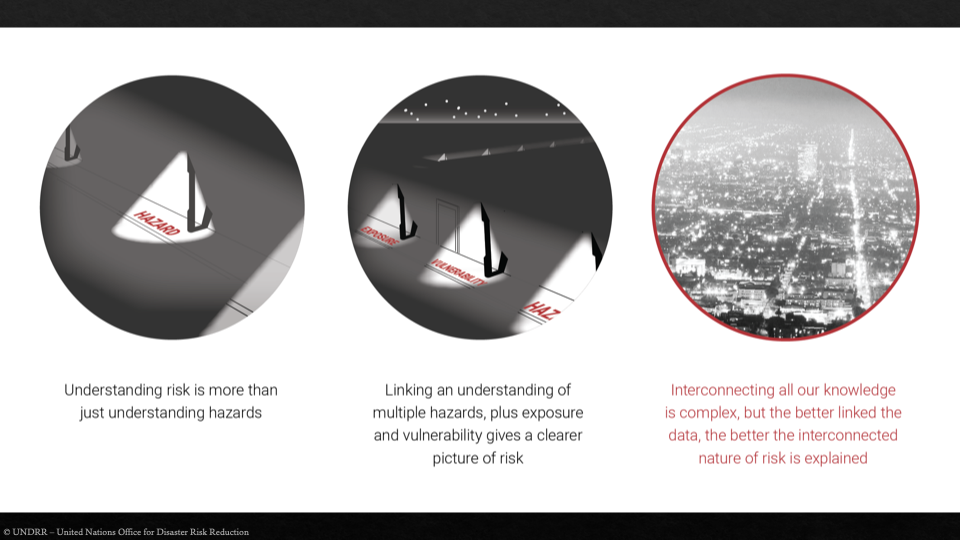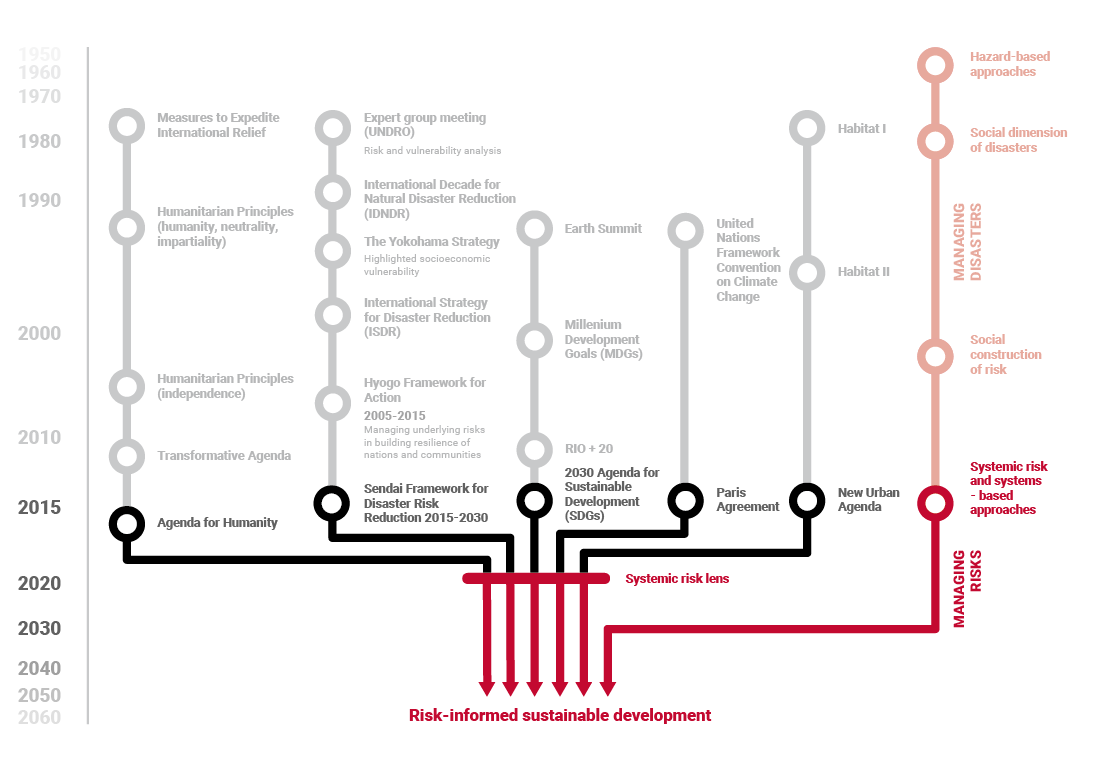Why does understanding the systemic nature of risk matter in the midst of COVID-19?
This is the first in a series of eight articles co-authored by Marc Gordon (@Marc4D_risk), UNDRR and Scott Williams (@Scott42195), building off the chapter on ‘Systemic Risk, the Sendai Framework and the 2030 Agenda’ included in the Global Assessment Report on Disaster Risk Reduction 2019. These articles explore the systemic nature of risk made visible by the COVID-19 global pandemic, what needs to change and how we can make the paradigm shift from managing disasters to managing risks.
There are profound implications in making the shift to a holistic understanding of risk as a dynamic three-dimensional topography that is constantly changing through time. This series of articles will elaborate on current and emerging approaches to assessing and analysing systemic risks; the fundamental characteristics of systemic risks; some of the possible approaches to governance of systemic risks; the importance of building collective intelligence and generating relational information to improve our ability to be sensitive to interdependencies and to ensure responses to systemic risks are informed by a systemic perspective; and finally, introduce the Global Risk Assessment Framework (GRAF), which is an open and collaborative global initiative to help the world better understand and manage the systemic nature of risk as embodied in the COVID-19 pandemic.

The preamble to the 2030 Agenda on Sustainable Development states that the Sustainable Development Goals (SDGs) are integrated and indivisible, balancing the three dimensions of sustainable development: economic, social and environmental. This century is likely to be dominated by the emergence of large-scale dynamic risks, like the COVID-19 global pandemic, that inherently cut across these three dimensions. The Sendai Framework for Disaster Risk Reduction 2015-2030 (the Sendai Framework) reflects the certainty that in an ever more populous, networked and globalizing society, the very nature and scale of risk has changed and continues to change, to such a degree that it surpasses established risk management institutions and approaches. The systemic nature of recent events arising since the initial COVID-19 outbreak at the end of 2019 carries the potential to generate diverse types of damage and destruction simultaneously, even to the life support systems of very large parts of societies and economies. Systemic risk is a critical lens to guide action now, and in the future.

With non-linear changes in hazard intensity and frequency - a reality now increasingly well understood by citizens and policymakers across the world - the imperative for greater ambition and accelerated systemic action is clear. COVID-19 compels new conceptual and analytical approaches to improve understanding and management of risk dynamics and complex, cascading risk drivers at a range of spatial and temporal scales. Understanding the dynamic and interactive nature - of zoonotic pandemics and other systemic risks - requires us to pay attention to the interactions and interdependencies between physical, technological, social and environmental hazards, and a heightened attention to “anthropogenic metabolism”.
Technical communities have used and continue to use models to better “see” risk in the present or near future, and so the view of risk is inherently shaped by the tools used to describe it. Most models have been based on historical data and observations, assuming that the past is areasonable guide to the present and the future. However, the COVID-19 global pandemic has made that assumption obsolete on almost every frontier: by the sheer number of human beings in almost every nation on Earth now infected, and by the dynamic and global connectedness of biological and physical worlds, individuals and communities.
The certainty of near-term non-linear changes calls us to revisit the critical assumption of the relationship between past and future risk. The Sendai Framework adopted almost exactly five years ago, defines a new era for the classification, description and management of risk. It stipulated that the global community must come to terms with a new understanding of the dynamic nature of systemic risks, establish new structures to govern risk in complex, adaptive systems and develop new tools for risk-informed decision-making and investments that allow human societies to live in, and with, uncertainty. The COVID-19 global pandemic has made visible the absence of significant efforts by countries and cities across the world to come to terms with the limitations of a hazard-by-hazard, siloed, fragmented view of risk management. Now is the time for the multi-stakeholder dialogue and action necessary to refine, extend and enhance the ability to understand and manage systemic risks unleashed by COVID-19. But do we have the courage to trust each other? How can we build that trust? What does that look like in an era of physical distancing requiring almost all human interactions to be online?
As has become apparent so far in 2020, today’s environmental, health, food, transportation and financial systems, supply chains, information and communication systems are complex, tightly coupled, fragile and clearly vulnerable. They also create vulnerability on multiple spatial scales (from local to global) and across different timescales (from immediate to weekly to monthly to decadal and beyond). They are challenged by, and are causal drivers of, disruptive influences such as infectious disease outbreaks, food shortages, social unrest, political instability, financial instability and increasing inequality.
The COVID-19 global pandemic is a complex manifestation of systemic risk. It includes elements of surprise and non-linearity. As with all complex risk events, significant underlying drivers - either unknown or underestimated – are exacerbating immediate and prolonged impacts. These include background conditions and contexts related to critical infrastructure placement, known but ignored vulnerabilities within and across key systems (including consumption drivers of high risk practices, for example in animal husbandry and ‘wet’ markets), and lack of redundancy in the quantity of limited systems (such as number of ventilators, number of ICU beds, number of ICU nurses and physicians).
In today’s globalized economic system, networks of communication and trade have generated highly interdependent social, technical and biological systems. These networks are built on, and have built-in, incentives to be highly efficient and to generate economic gains. This narrow focus requires the elimination of contexts and means there are very often undetected fragilities that produce an array of changing systemic risks.
In effect, through global interconnectedness, human civilization has become a “super-organism”, changing the environment from which it evolved, and inducing new hazards with no analogue - such as the COVID-19 global pandemic. Despite technical and analytical capabilities and the vast webs of information about social and Earth systems, human society is increasingly unable to manage the risks which we create at the scale of COVID-19; even understanding is challenging.
Many of those in positions of influence and with decision making authority have also been slow to realize that the degradation of the Earth’s natural systems is becoming a source of large-scale, even existential, threat affecting fragile social systems at local, national, regional and global scales. Far-reaching changes to the structure and function of the Earth’s natural systems represent a growing threat to human health. While global economic integration continues to strengthen resilience to smaller shocks through trade adjustments and other measures, increasingly integrated network structures are creating expanding vulnerabilities to novel systemic risks like COVID-19.
The behaviour of these integrated and interdependent networks defines the quality of life possible for billions of people and shapes the dynamic interactions across the Sendai Framework, the 2030 Agenda, the Paris Agreement, the New Urban Agenda, the Convention on Biological Diversity and the Agenda for Humanity among other major intergovernmental agreements and processes.
Ultimately, the behaviour of these systems of systems determines the contexts of exposure and vulnerability of people, economies, and ecologies at all scales. The regenerative potential of the social and natural systems envisaged in the aligned intergovernmental agendas will be better understood, and progress will be accelerated towards risk-informed sustainable development and regeneration, by incorporating systemic risk and systemic opportunity into the design of policies and investments across all scales.
The next article in this series explores the way systemic risks are embedded in the complex networks of an increasingly interconnected and interdependent world and why current approaches to understanding and managing risks require a fundamental rethink and redesign in the age of systemic risks.